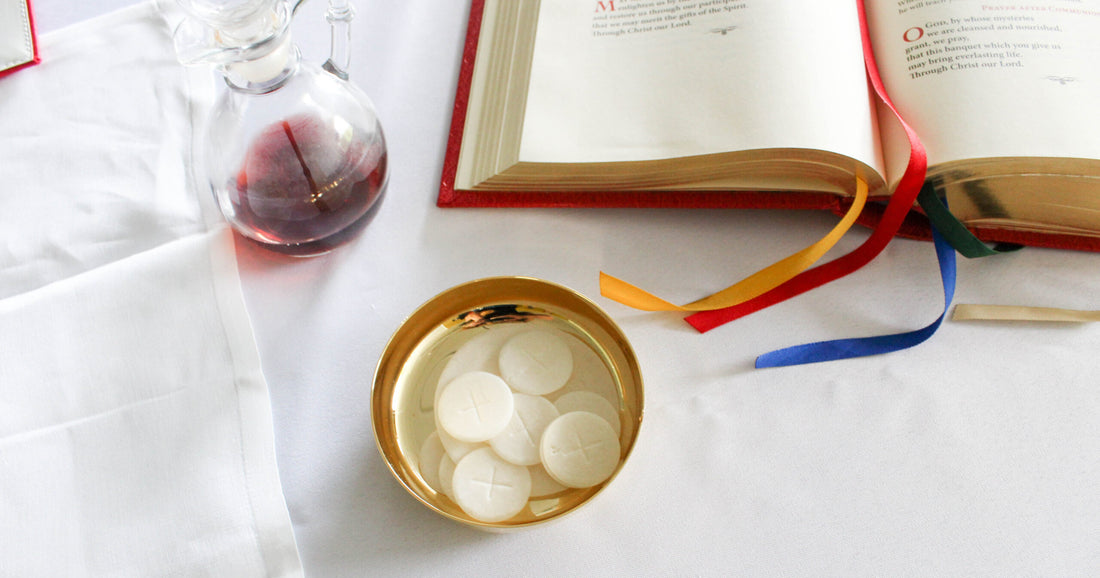
A Quick Primer on Transubstantiation
Chris MuellerEvery time the Mass is celebrated, something incredible happens. A miracle takes place. During the Eucharistic rite, the priest speaks Jesus’ words from the Last Supper:
“Take, eat; this is my body.” And he took a cup, and when he had given thanks he gave it to them, saying, “Drink of it, all of you; for this is my blood of the covenant, which is poured out for many for the forgiveness of sins. …” (Matthew 26:26-28)
The simple unleavened hosts and wine become the actual Body and Blood of our Savior, Jesus Christ.
It is more than just a symbolic meal, it is an actual partaking in the real presence of Jesus Christ. In the Eucharist, Jesus becomes fully present to us. It is more than dead flesh. He is alive! The Eucharist is his Body, his Blood, his Soul and his Divinity. We actually consume the real presence of Jesus Christ and invite him to unite us more fully to him.
All of that is true. Yet, you may have noticed that upon receiving the Eucharist, it does not actually appear to be any different than it was before its consecration. In fact, most of the time, there is absolutely no physical evidence that a change has occurred at all. So what gives? How can it be Jesus when it looks and tastes like bread and wine? The word the Church uses to help us understand is transubstantiation.
Discover the Beauty and Riches of the Mass
A Biblical Walk Through the Mass explores the extraordinary biblical roots of the Liturgy and reveals what it all means and why it all matters.
Breaking Down the Word
It isn’t a word that is used all that often outside of the Church. In fact, the word was created specifically to describe the Eucharist. So, what does it mean? Let’s break the word down to find out.
The first part of the word, “trans”, indicates a change. The second half of the word refers to what is being changed; in the case of transubstantiation, the substantia, or substance. Put the two parts together and what the word is telling us is that the substance is changing. This is important in understanding what takes place.
Please note, the Church does not tell us that a transformation is taking place. In transformation, the form changes. As we already discussed, that’s not what happens at the consecration. The form stays the same. It is the substance that changes. The “what it is” changes, not the “what it looks like.” OK, that can still be a little confusing.
Form and Substance
Well, If I laid down a pork chop and filet minion in front of you, you’d probably have no problem in agreeing with me that both are flesh. The substance, what they are, can be said to be the same. They are flesh. They only differ—to use the language of St. Thomas Aquinas—in the accidents; meaning the look, touch, taste, and so on. The color of the meat does not make it meat. The taste does not make it flesh. Pork and beef taste and look quite different, yet they are still both meat. The accidents don’t change the substance.
Another example might be to consider two forty-year-old men. Both are in substance, the same: human men. But, one might have blond hair and blue eyes while the other has red hair and green eyes. One might have dark skin, while the other has light skin. One might be three hundred pounds and the other a buck forty-five. That all may be true, but they are still men. The accidents, what they look like, do not change the substance, what they are.
Well, the Church tells us that the Eucharist—while it retains the accidents (look, taste, feel, etc.) of bread—in substance is changed to the Body, Blood, Soul, and Divinity of Christ. Yes, it is a little hard to comprehend. It’s a big leap to say that while it looks, tastes, and feels like bread, it is in substance Jesus. But, that is what happens. The reality is this is something that can be explained with the language of philosophy, as I have just tried to do, but only fully accepted with the eyes of faith. St. Thomas Aquinas, in the beautiful hymn, Tantum Ergo writes about this:
Down in adoration falling,
Lo! the sacred Host we hail;
Lo! o’er ancient forms departing,
Newer rites of grace prevail;
Faith for all defects supplying,
Where the feeble senses fail.
Did you catch that last part? When we encounter the Eucharist, the Church teaches that we encounter Christ. When we receive it, we receive him. The form of the bread and wine may not have changed, but the substance, the “what it is” has. Yes, that is a little confusing. That’s OK. This Sunday, invite Jesus to supply the faith needed to see him where your senses may fail to do so.
Discover the Beauty and Riches of the Mass
A Biblical Walk Through the Mass explores the extraordinary biblical roots of the Liturgy and reveals what it all means and why it all matters.